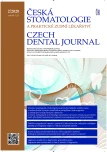Vagueness and Exactiveness in class II, division 2 diagnostics
Authors:
P. Jindra
Authors‘ workplace:
Soukromá ortodontická praxe Ortodoncie Jindra, s. r. o., České Budějovice
Published in:
Česká stomatologie / Praktické zubní lékařství, ročník 120, 2020, 2, s. 56-61
Category:
Opinion piece
Overview
Introduction, aim: Class II division 2 malocclusion is usually defined by natural informal language (czech, english etc.) as a combination of deep bite and upper central incisor retrusion. There are borderline cases of deep bite and incisor retrusion, which cause doubts about class II division 2 diagnostics. The existence of borderline cases is a sign of vague definition of examined phenomenon.
The goal of presented article is to analyze concepts of vagueness and exactiveness in class II division 2 diagnostics. A quantity distance and a quantity angle will be analyzed, which enable mathematization of class II division 2 diagnostics.
Opinion piece and conclusion: The description of real world around us and of orofacial systems of our patients by means of quantities is a method of exact sciences. The article analyzes the difference between vagueness and exactiveness during class II division 2 diagnostics. In dentistry we use both filters of real world complexity. We use vagueness as we talk and write about dentistry phenomena using natural informal language. But we use tools of exactiveness as well as we introduce quantities in a suitable way and we describe phenomena by quantities and their relations.
Keywords:
quantity – vagueness – exactiveness – maloclussion of class II – division 2 – retrusion of incisors – mathematization
Sources
1. Kamínek M et al. Ortodoncie. 1. vydání. Praha: Galén; 2014.
2. Křemen J. Modely a systémy. 1. vydání, Praha: Academia; 2007.
3. Bock N, Ruf S. Post-treatment occlusal changes in Class II division 2 subjects treated with the Herbst appliance. Eur J Orthodontics. 2008; 30(6): 606–613.
4. Isik F, Nalbantgil D, Sayinsu K, Arun T. A comparative study of cephalometric andarch width characteristics of Class II division 1 and division 2 malocclusions. Eur J Orthodontics. 2006; 28(2): 179-183.
5. McIntyre GT, Millett DT. Lip Shape and Position in Class II division 2 Malocclusion. Angle Orthodontist. 2006; 76(5): 739–744.
6. Proffit WR, Fields HW, Sarver DM. Contemporary orthodontics. 5. vydání. St. Louis: Elsevier Mosby; 2013.
7. Sepanian VF, Sonnesen L. Incisor root resorption in class II division 2 patients in relation to orthodontic treatment. Eur J Orthodontics. 2018; 40(3): 337–342.
8. Devreese H, De Pauw G, Van Maele G, Kuijpers-Jagtman AM, Dermaut L. Stability of upper incisor inclination changes in Class II division 2 patients. Eur J Orthodontics. 2007; 29(3): 314–320.
9. Stanford Encyclopedia of Philosophy. Vagueness [cit. 1.12. 2019]. Dostupné z: https://plato.stanford.edu/entries/vagueness/
10. Hariharan A, Diwakar NR, Jayanthi K, Hema HM, Deepukrishna S, Ghaste SR. Tle reliability of cephalometric measurements in oral and maxillofacial imaging: Cone beam computed tomography versus two-dimensional digital cephalograms. Indian J Dent Res. 2016; 27(4): 370–377.
11. Jindra P. Chcete pochopit zuby? 1. vydání. Lukáš Vik; 2019.
12. Lundström F, Lundström A. Natural head position as a basis for cephalometric analysis. Amer J Orthodont Dentofacial Orthop. 1992; 101(3): 244−247.
13. Pilon JJGM, Kuijpers-Jagtman AM, Maltha JC. Magnitude of orthodontic forces and rate of bodily tooth movement. An experimental study. Amer J Orthodont Dentofacial Orthop. 1996; 110(1): 16–23.
14. Rickles D, Hawe P, Shiell A. A simple guide to chaos and complexity. J Epidemiol Community Health. 2007; 61(11): 933–937.
15. Stewart I. Hraje Bůh kostky? Nová matematika chaosu. 1. české vydání. Praha: Argo Dokořán; 2009.
Labels
Maxillofacial surgery Orthodontics Dental medicineArticle was published in
Czech Dental Journal

2020 Issue 2
- What Effect Can Be Expected from Limosilactobacillus reuteri in Mucositis and Peri-Implantitis?
- The Importance of Limosilactobacillus reuteri in Administration to Diabetics with Gingivitis
Most read in this issue
- Healing of endodontic periodontal lesion after non-surgical treatment
- Stability of orthognatic surgery in cleft lip and palate patients
- Doporučená ochrana před přenosem virových infekčních onemocnění v době epidemií, nyní zejména SARS-CoV-2/COVID-19
- A clinical, radiographic and histologic observation of human immature permanent tooth after failed revitalization treatment and subsequent root canal treatment
